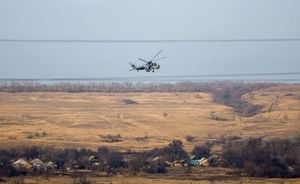India's wholesale inflation, based on the Wholesale Price Index (WPI), soared to 2.36% in October, marking the highest level seen over the last four months. This uptick has been predominantly attributed to significant surges in food prices, particularly vegetables and staples such as potatoes. The increase reflects broader trends noted across other inflation indicators, including the Consumer Price Index (CPI) which has spiked to 6.2%, the highest inflation rate reported over the past 14 months.
The rise from September's WPI figure of 1.84% to October's 2.36% signals growing inflationary pressures on consumer goods. According to the Ministry of Commerce and Industry, wholesale food inflation has jumped to 13.54% this month, up from 11.53% previously. The continuous increase is largely driven by dramatic rises in specific vegetable prices—vegetables alone reported inflation of 63.04%. Potatoes have experienced an astonishing inflation rate of 78.73%, closely followed by onions at 39.25%. Even other food items haven’t been spared, with fruits rising by 13.55% and wheat incrementing by 8.04%.
This latest round of inflation isn’t isolated to food; it has hit multiple sectors including manufactured products, which comprise over 64% of the WPI. The inflation for these manufactured goods edged up to 1.5% from the previous month’s figure of 1%. Notable categories contributing to this increase include manufactured food products, vegetable oils, and beverages.
On the flip side, fuel and power prices saw some relief, continuing their contraction. Prices for high-speed diesel and petrol have dropped by 6.23% and 7.35%, respectively, creating contrasting dynamics between food-related inflation and energy costs. While fuel prices eased, cooking gas has shown only limited growth with prices increasing by 2.57%. These variances paint different narratives across various inflation categories.
The WPI data for October outlines significant volatility observed this year, with the inflation rate peaking at 2.74% back in May and sinking as low as 0.2% in February. Now, driven primarily by soaring food costs, the latest figures highlight how food inflation continues to be the most pressing concern. While the commodity prices globally have remained relatively stable, they haven’t been immune to local fluctuations and seasonal pressures felt distinctly across food supplies.
Economic analysts have been quick to weigh in on these developments. Paras Jasrai, Senior Economic Analyst at India Ratings, indicated the persistence of food inflation as the key factor behind this month’s increase, though core inflation—the inflation rate of non-food items—remains surprisingly high but steady at just 0.3%. This suggests areas like metals and chemicals maintain stability, counterbalancing the food price spikes.
The backdrop of this inflation surge reflects historical contexts where prices have shown resilience to various market pressures. For consumers, the potential effectiveness of the Reserve Bank of India’s policies will significantly depend on how inflation trends onto the new year, what fiscal measures they employ, and how sustainably they can dampen inflation without hindering economic growth.
October’s metrics yield broader questions about economic health and policy direction. With retail inflation consistently exceeding the Reserve Bank of India’s target range of 2-4% for over two months, expectations for interest rate cuts are dwindling. The findings of this WPI report signal to policymakers and economists alike just how sensitive the economy is to fluctuations primarily driven by food prices and manufactured goods' cost impact.
The reality of inflated costs leads consumers to question everyday expenses and reflect on their budgeting for basic needs. Hopes for any immediate relief via subsidization or price control seem uncertain as inflation exhibits resilience amid global commodity stabilizations.
Looking forward to November's inflation report, it’s clear the economic narratives will need monitoring closely, with local agricultural performance playing even larger roles amid agri-weather assessments. With the harvest season underway, outcomes from this year’s series of weather impacts on crop yields may play substantial roles heading toward year-end financial assessments and economic outlooks for 2025. Fiscal health and budget allocations within policy-making silos must acknowledge and address these inflation drivers effectively.



